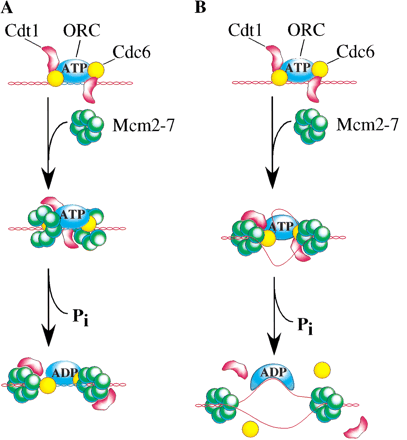The MCM (mini-chromosome maintenance) proteins are a family of related proteins required for the initiation of DNA replication. Studies of MCM proteins suggest that they act in collaboration during an early step in the initiation of DNA replication (Lee 2000). MCM proteins contain a sequence domain that indicates the possession of DNA helicase / DNA-dependent ATPase activity. Direct biochemical demonstration of this helicase activity in individual MCM proteins is difficult, however, current evidence suggests that the activity is associated with a sub-complex consisting of MCM2-7 (Mendez 2000). Accordingly, the six classes of MCM proteins are referred to as MCM2-MCM7.More current evidence also reveals that MCM proteins are key players in the initiation of S. cerevisiae DNA replication (Tye 1999).
The activity of the MCM complex firstly displaces, at least temporarily, the PRC from the origin and secondly allows Cdc45-mediated access to the template of the initiation complex, including primase and DNA polymerase. This implies that strand separation has occurred to allow the formation of a replication bubble. Further evidence suggests that is the helicase activity of the MCM complexes that remain associated with or even generate the two moving replication forks, consistent with their DNA helicase activity (Tye 1999). However, this may not be true for all eukaryotes.
Despite the abundance and highly conserved nature of the MCM proteins, the biochemical function remains obscure (Mendez 2000). The sequences suggest that they utilize ATP hydrolysis to perform their functions. Helicase function, ATP-dependant chromatin disruption, and origin DNA unwinding are all possible roles for ATP hydrolysis. It is also possible that MCM proteins could mediate that association of the polymerase with chromatin.

ORC-complex and the utilization of ATP (Bell 2002).